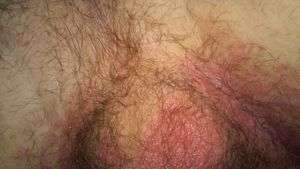Tinea cruris
Background
- Dermatophyte infection involving the crural fold
- Colloquially known as 'jock itch'
- Most commonly caused by Tinea rubrum
- More common in men than women
- May result from the spread of other concurrent tinea infections
- More common in obese, diabetics, and immunodeficient
Clinical Features

Tinea cruris
- Begins with an erythematous patch on the proximal medial thigh
- Inward spread with partial central clearing
- Sharply demarcated border, erythematous, elevated
- May spread to perineum, perianally, onto buttocks, or into gluteal cleft
- Typically spares the scrotum
Differential Diagnosis
- Erythrasma (Coral red fluorescence with Wood's lamp)
- Seborrheic dermatitis
- Candidal intertrigo (Erythematous patches with satellite lesions)
- Inverse psoriasis
Evaluation
- Typically a clinical diagnosis
- Scraped skin from affected area in KOH prep will show segmented hyphae
Management
- Topical antifungals: Clotrimazole, terbinafine
- treatment to reduce symptoms, prevent secondary bacterial infection, and limit spread
- Systemic antifungals reserved for patients who fail topical therapy
- Systemic antifungals that can be used include: terbinafine, itraconazole, and fluconazole
Disposition
- Outpatient
See Also
References
UpToDate, Tinitnalli's
This article is issued from
Wikem.
The text is licensed under Creative
Commons - Attribution - Sharealike.
Additional terms may apply for the media files.